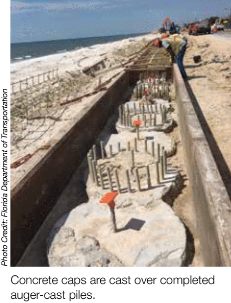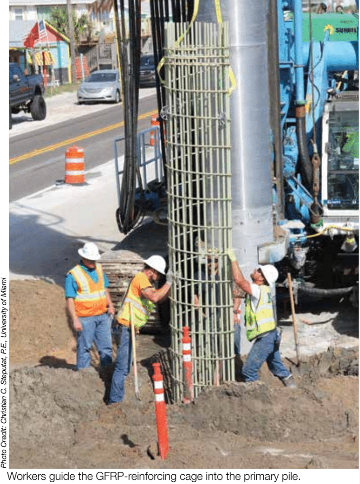

Florida Community Protected from Future Storms
During Hurricane Matthew in 2016, sections of state Route A1A in Flagler Beach, Fla., – a key highway and hurricane evacuation route – collapsed. The Florida Department of Transportation (FDOT) recently installed a 5,000-foot-long GFRP-reinforced concrete seawall to protect the state highway from future storm surges.
GFRP beat out traditional steel rebar based on life-cycle cost analysis for the rebuilding project because of its extreme durability. The seawall along Flagler Beach is expected to last 100 years or more with little to no maintenance.
“The biggest thing with steel-reinforced marine structures is that once chlorides get into the concrete and the reinforcing, you get rust, degraded concrete and even pieces falling off,” says Lowry Denty, P.E. of Mott MacDonald Florida, LLC, the engineer of record for the project. “It’s a lot of repairs.” In contrast, the GFRP-reinforced seawall “should never have any maintenance issues until it reaches its design life,” he says.

The seawall contains 1,847 piles with GFRP rebar and rebar cages supplied by Pultrall Inc., an FDOT-approved fiberglass reinforcement manufacturer in Thetford Mines, Quebec, Canada. The company’s V-Rod rebar, made from high-strength glass fibers and vinyl ester resin, is pultruded, cured and then sand coated to increase concrete bonding capacity. Each V-Rod batch utilized on the seawall project was third-party tested at the University of Miami, which partners with FDOT on GFRP projects.
The Flagler Beach seawall is an auger-cast secant-pile wall system. The 36-foot-long, 3-foot-diameter piles were drilled with a steel tube encased hollow auger. Cement grout was then pumped in through the auger as it was withdrawn from the tube, and GFRP reinforcement was installed. To create the secant pile wall, 924 load-bearing primary piles that were heavily reinforced with conical GFRP cages were alternated and overlapped with 923 non-structural secondary piles reinforced with a single GFRP bar. After the piles were completed, a 4-foot-wide GFRP-reinforced concrete cap was cast on top, and the entire structure was covered with a sand dune.
Roxanne Fortier, sales coordinator for Pultrall, says contractors on the Flagler Beach project, who had not worked with GFRP before, needed reassurance. “Getting the contractor to have confidence in us and in the quality of the product was quite hard to do in the beginning,” she explains. The foremost concern was production time. V-Rod is made to order at Pultrall’s facility with two to four weeks’ lead time.
This especially affected the primary pile cages, which were assembled by tying 25 straight V-Rod bars together at one end with a special pile-toe assembly, spreading the bars into a cone shape and then securing them with outside spiral hoops. Pultrall delivered enough pre-cut and preformed V-Rod for 104 cages a week for nine weeks, including 300,000 linear feet of No. 5 spiral GFRP rebar. (Rebar numbers represent a unit of 1/8-inch, so No. 5 rebar has a 5/8-inch diameter.) Fortier says that once the contractor adjusted to the process, it appreciated the convenience of receiving ready-to-assemble components.
Receiving pre-cut, pre-bent V-Rod significantly reduced on-site assembly time. At one-quarter the weight of steel rebar, using V-Rod also greatly reduced worker fatigue during cage assembly. Christian C. Steputat, P.E., a Ph.D. candidate at the University of Miami who monitored the installation of the GFRP rebar, estimates that the use of GFRP bar cages for the Flagler Beach seawall reduced installation time by up to 52%.
Although the lighter GFRP cages offered distinct advantages, they did present one challenge. “Typically with a steel cage, you’re able to drop it into the concrete, and it will pretty much go all the way down with its own weight,” explains Denty. “Whereas these [GFRP] cages are so light, they have to be physically pushed down.” However, FDOT specifications for auger-cast piles forbid mechanical pushing, so a variance from the FDOT was needed. “That specification wasn’t necessarily written for GFRP,” notes Denty.
The contractor on the project wasn’t the only company with little to no experience with composites. For Denty, the engineer of record, this was only his second infrastructure project with GFRP rebar. Initially, his firm designed the Flagler Beach seawall with steel-reinforced secant piles, but the FDOT was concerned about long-term maintenance and asked the firm to consider GFRP. “That was unexpected,” admits Denty.
Shifting from steel to GFRP rebar required a few design changes. Because the largest FDOT-approved GFRP bar at the time was a smaller No. 8 bar, the number of bars in each cage was increased. “We originally designed this for traditional steel, so we had nine No. 11 bars in a cage,” says Denty. “When we switched to GFRP, we ended up going with 25 No. 8s.”

Grout requirements also changed. The cement grout no longer needed silica fume, which was originally specified to create the denser grout needed to protect the steel rebar from corrosion. The non-corrosive GFRP rebar also allowed for a reduction of grout cover around each cage from four inches to three.
As a newer material, GFRP rebar does present some growing pains. For one thing, it’s difficult to find engineering software that allows for design with the material. For this project, Denty says that his team had to develop their own spreadsheets based on the code formulas. In addition, because GFRP bars are lighter and more flexible, contractors must be careful to ensure the cages are assembled straight, tied very securely together and supported or lifted at more locations than conventional practice, according to the FDOT.
Meanwhile, the use of GFRP rebar on bridges, seawalls and other infrastructure projects continues to grow. Coastal areas like Florida, where infrastructure battles against chloride-heavy, extreme marine environments, are leading the charge. Given the age and amount of existing coastal infrastructure, the population growth rate and future sea level encroachment, there appears to be ample opportunity for FRP reinforcement to find a sustainable market in Florida and other similarly positioned states.

SUBSCRIBE TO CM MAGAZINE
Composites Manufacturing Magazine is the official publication of the American Composites Manufacturers Association. Subscribe to get a free annual subscription to Composites Manufacturing Magazine and receive composites industry insights you can’t get anywhere else.



